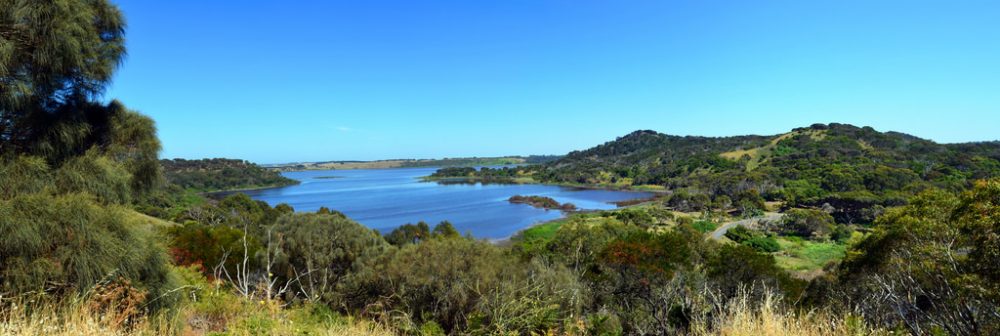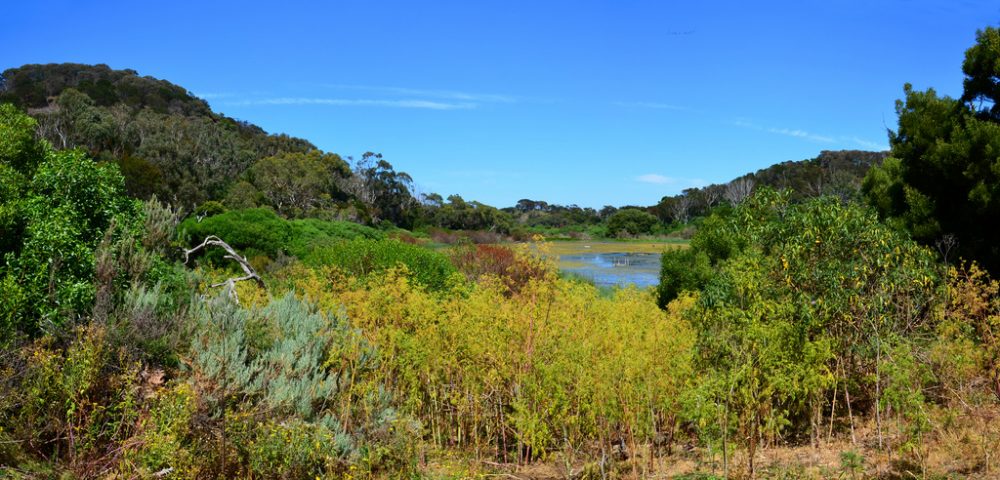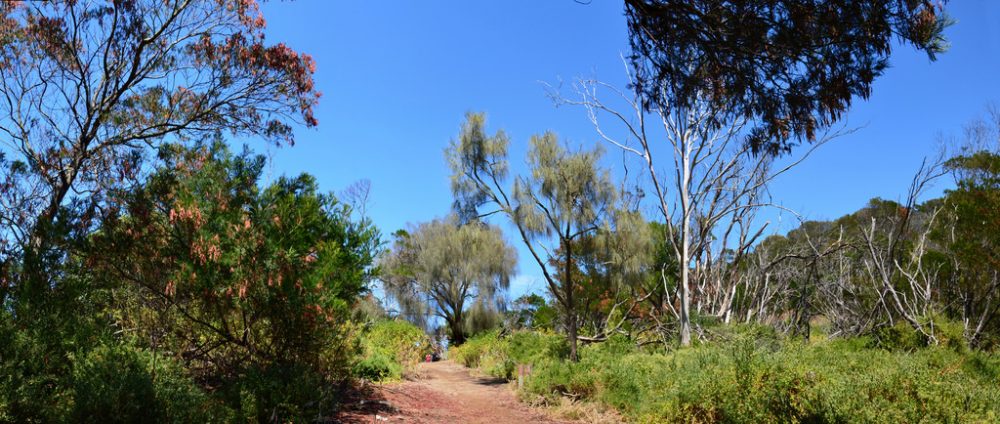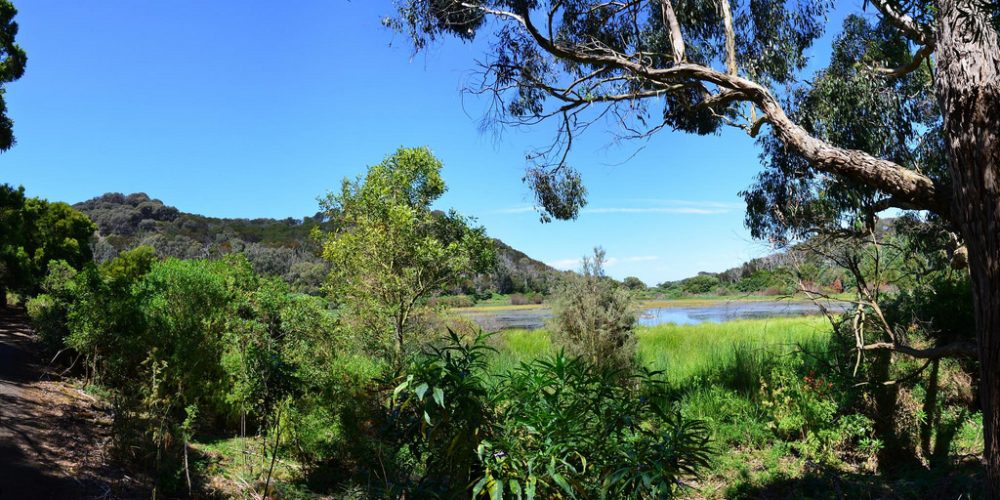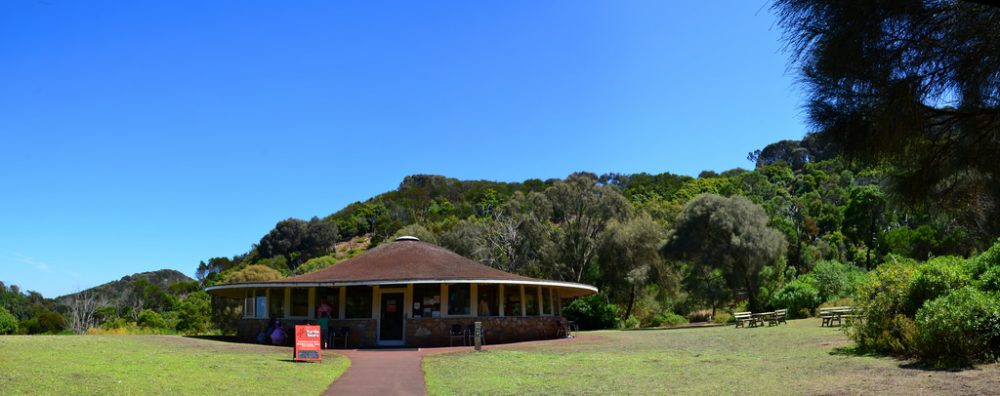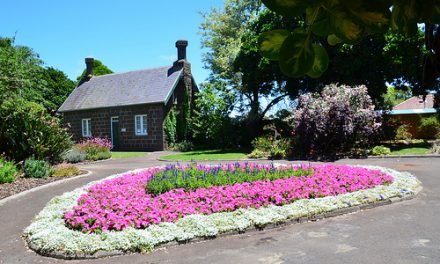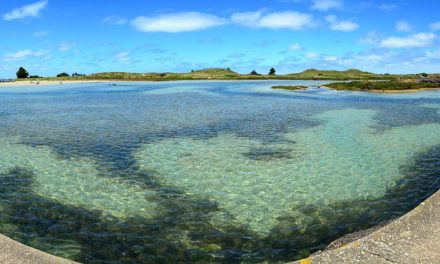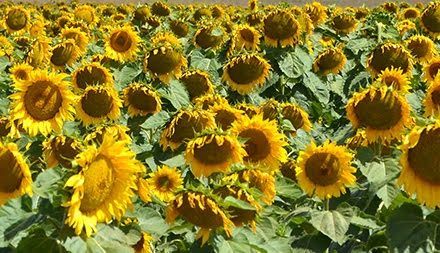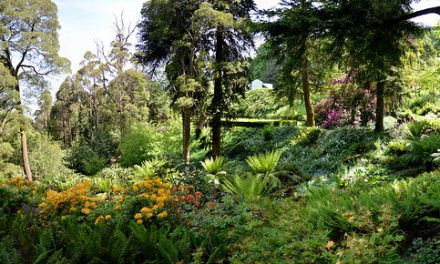Tower Hill is an extinct volcano 275 km southwest of Melbourne, between Warrnambool and Port Fairy, on the Princes Highway (GPS coordinates S38.319084, E142.363028). A violent volcanic eruption 30,000 years ago created a funnel-shaped crater with a distinctive rim formed from deposition of layers of scoria, ash, limestone and clay fragments around it.
Subsequent volcanic activity formed a series of small scoria cones within the main crater. These became islands in a lake when the crater filled up with water.
Tower Hill lies at the western end of a line of 30 similar volcanoes, which extends from Colac to Port Fairy. Measuring 4 km wide and 80 m high, it is one of the largest maars in the world and is of national geological significance due to the complex nature of its formation. In recognition of its unique features, it was declared Victoria’s first national park in 1892 and was Victoria’s only national park for many years.
The fertile volcanic soils supported a diverse range of vegetation including Manna Gum, Blackwood, Black Wattle, Swamp Gum and Drooping Sheoak which attracted fauna. These became a rich source of food for the Koroitgundidj people living in the area at the time of the eruption. Archaeological surveys of the area have uncovered axe heads and other aboriginal artefacts in the volcanic ash layers. Today the Worn Gundidj Aboriginal Cooperative manages the reserve’s Information Centre.
Tower Hill is close to the coast and easily seen from the sea. The first confirmed European sighting of Tower Hill was by French explorers sailing with Captain Nicolas Baudin aboard the ship Le Géographe in 1802, though there are theories suggesting Tower Hill may have been seen by the Portuguese as early as the 17th century. Matthew Flinders, sailing east along the southern coast of Australia, recorded on 20 April 1802 “Peaked Hill position uncertain” in his chart close to the actual location of Tower Hill.
A school inspector James Bonwick waxed lyrical about Tower Hill when he visited it in 1857: “A stroll among the gigantic ferns of the valley … a ramble among the cones and craters …the winding path at the foot of the basaltic rises close to the lake … almost tropical reeds rustle in the breeze … leafy shrubs and trees form delightful bowers and alcoves … tender emotion in suitable company”.
Bonwick ended with a passionate plea to preserve something of the volcano: “Let the few who value sentiment in the colony [who] sympathize with nature, who love an undisturbed communion with the grand and sublime, join one and all in securing for themselves and posterity the authorized declaration that Tower Hill shall be an everlasting reserve.”
Bonwick’s words went unheeded for nearly 10 years. Over the decades of European settlement, the site was rapidly degraded and much of the natural vegetation was cleared for grazing, growing crops, quarrying and logging.
In 1866, some areas of Tower Hill were reserved as public land and the government appointed the Tower Hill Acclimatisation Society to manage the reserve. In order to raise funds for fencing and rangers, the self-supporting Society permitted more timber felling, grazing and clearing, and let people live on parts of the reserve, further contributing to the degradation of the vegetation. In pursuit of their ideals, they also planted exotic trees and introduced rabbits, goats and other animals. By the time the National Parks Act was enacted in 1956, Tower Hill was omitted because it had virtually been stripped bare and the only wildlife to be found were waterfowl that came to the crater lakes.
In 1961, it became a State Game Reserve and under the then Fisheries and Game Department, a major revegetation program began. Little was known about the original vegetation until a dusty painting named “Outlook” by Viennese artist cum botanist Eugene Von Guerard resurfaced. Von Guerard was commissioned in 1855 by James Dawson, owner of “Kangatong“, a pastoral property near Mount Eccles to the west, to show the vegetation as the Aborigines knew it and just before the Europeans were to ruin it. On a visit to Tower Hill in 1891, Dawson was appalled at the condition of the place and was glad he had the foresight to commission the painting: “….fortunately for future generations, I commissioned a celebrated artist to paint the scene in oil on a large scale, and he carried out my wishes faithfully and beautifully. On visiting the scene later, I was amazed and disgusted to find everything altered, the fine trees on the cones, and in the craters of the island all gone excepting half a dozen or so.”
Painted from Von Guerard Lookout (refer to Google Map below) which I did not visit
Dawson’s initiative in having the relatively undisturbed scene captured on canvas, however, proved to be more valuable than he could have dreamed. In 1966, Mrs E. Thornton, the grand-daughter of James Dawson, presented the painting to the Victorian Fisheries and Wildlife Division. The painting shows grass and ferns on the island, teatrees, wattles, sheoaks, banksias and eucalypts on the cones with reeds and tussocks in the marshes. It is so detailed that botanists were able to identify some individual plant species. With the invaluable assistance of many volunteer groups, more than 300,000 native trees have been planted in the last 40 years. As these plants became established, introduced plants and weeds were removed. More recently, pollen analysis at Tower Hill has helped identify other plants growing prior to European settlement.
Native wildlife that have been successfully reintroduced include koalas, emus, grey kangaroos, wombats, sugar gliders, magpie geese, echidnas, brushtails and ringtail possums. The aim of the restoration program today is to reintroduce indigenous understorey plants, including ferns and grasses. You can read more about the future directions of Tower Hill here.
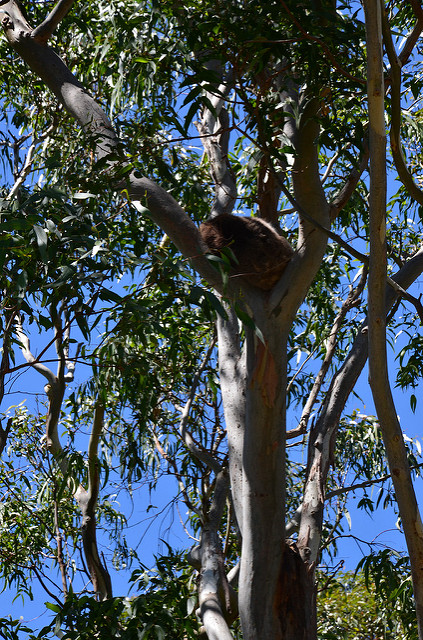 |
 |
Tower Hill is divided into 3 principal areas: Main Island, Fairy Island and Hat Island. There are several self-guided walks, each with a different theme.
- Wagon Bay Loop (30 mins, easy)
- Lava Tongue Boardwalk (wetlands – 30 mins, easy)
- Peak Climb (orientation and geology – 30 mins, steep)
- Hat Island Habitat Track (revegetation – 45 mins, easy)
- Whurrong Walk (Aboriginal foods – 1 hour, easy)
- Journey to the Last Volcano (geology – 1 hour, moderate).
All walks start from the picnic area, except for the Whurrong walk, which begins near the bird hide. Additional tracks can be used to link several of the above walks. Click here to download the map. I have created a Google Map of Tower Hill.
View Tower Hill, Victoria in a larger map
As my wife was tired, she refused to do any walking. The kids had dozed off during the journey and while they were sleeping in the car, I made the half-hour Wagon Bay Loop, where I took the video of the roaming emus in their natural habitat as well as the Lava Tongue Boardwalk, shown in the photo below. When I returned, the kids had just woken and it was the right time to have lunch in the nice picnic ground, in the company of emus and koalas.
Besides picnic tables, there are also free barbecues and toilets. The Worn Gundidj Visitor Centre on Main Island has displays on the geology, flora, fauna and human history of Tower Hill as well as an account of the revegetation story, linking it to a magnificent colour reproduction of Eugene von Guérard’s invaluable painting. It is open on weekdays between 9am and 5pm and 10am–4pm during weekends and public holidays.
The building, made of local material in the shape of a volcanic cone, is designed by Melbourne architect Robin Boyd who played a major role in the development of architecture in Victoria from the 1940s to 1970s. It was completed around 1970.
Nestled on the northern slopes of Tower Hill is Koroit, a small town rich with Irish heritage. The discovery of gold in Tower Hill Lake, the resulting demand for agricultural produce and the devastating potato famine of the 1840s encouraged many Irish families to settle in the area. Koroit now boasts Australia’s largest concentration of people of Irish descent and proudly celebrates its heritage with an annual Irish Festival on the weekend before the first Thursday in May. To know more about its attractions, click a, b.
I did not visit Koroit and my tour of Tower Hill is very brief so I will return in the future if I could. I hope that Tower Hill will regain its national park status one day.


